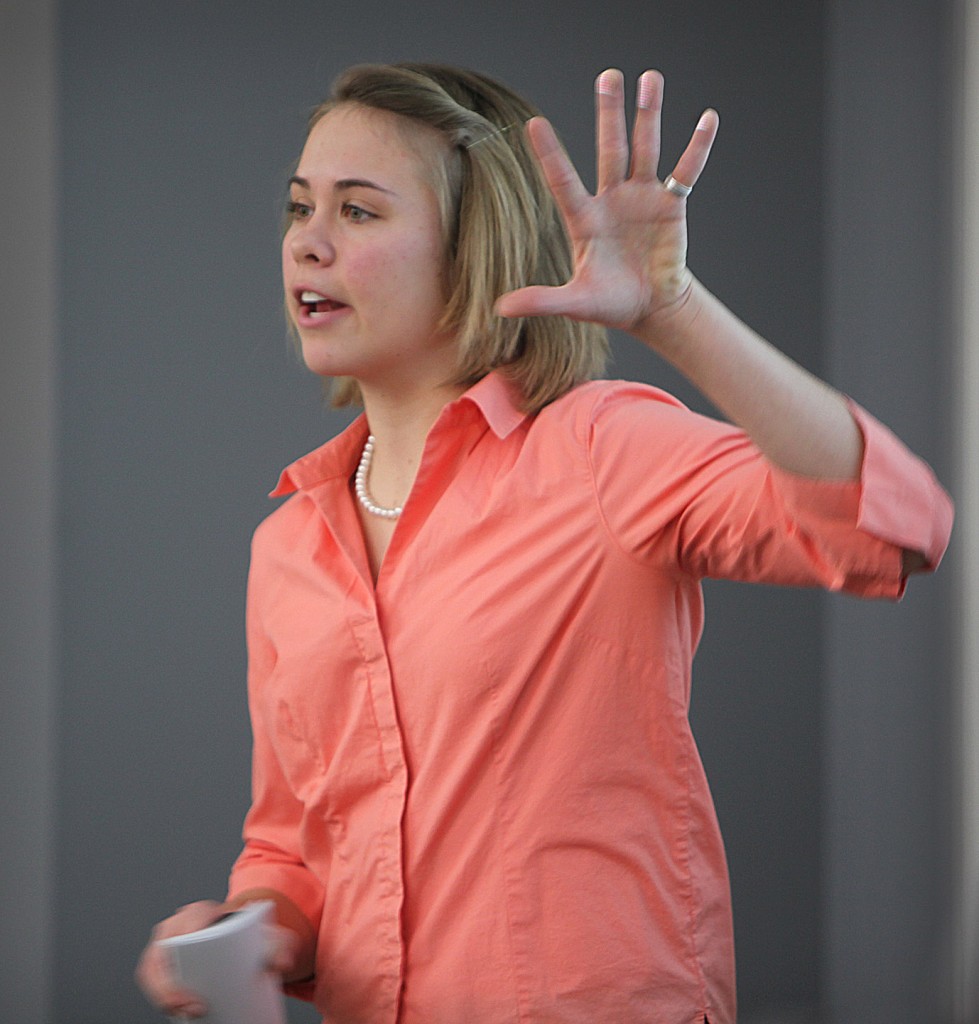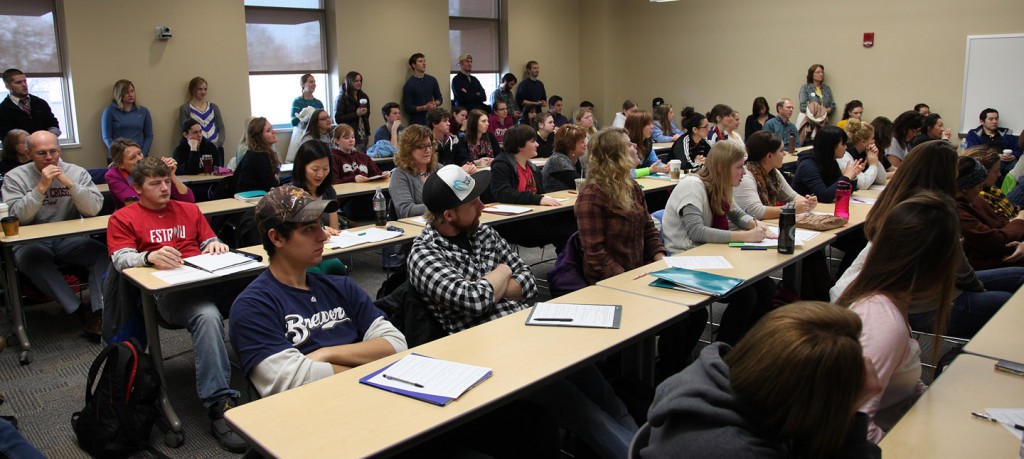Posted 12:34 a.m. Wednesday, Jan. 16, 2013

Recent UW-L graduate interviews homeless population for final research project and discovers the power of narrative for those without a home.
 [/caption]
Sadie Tennessen’s student research cuts through stereotypes and focuses on real stories. After spending 120 hours at The Salvation Army, sitting and talking with homeless families, the recent UW-L graduate discovered the power of narrative for those without a home.
Tennessen has heard plenty of stereotypes about the homeless such as they’re lazy and not looking for work or housing. After making an effort to listen, she says those stereotypes are untrue. But her research dug deeper as she sought to understand how family values and norms are communicated through family storytelling within this population.
For her final research project as a UW-L Communications Studies major, she studied the stories they told each other. She then applied the Narrative Performance Theory, a theory that storytelling is an important means for families to share meaning about themselves, revealing values, identity, family norms and more.
“It’s fascinating how you can pull so much from a story,” she explains.
Tennessen says her research was a way for her to combine the experience and interests she developed during her education at UW-L. For example, she has minors in sociology and psychology, and experience volunteering with WAFER Food Pantry.
All Communication Studies majors must complete or pass "core research curriculum" to graduate. A series of four courses, over the course of two or more semesters, prepares them for a final project that is formally presented.
“We have found a clever way to use our limited resources and ensure students have a strong experience, which includes instructor supervision for the project in the same way a grad student would have a thesis adviser,” notes Linda Dickmeyer, chair of UW-L’s Communication Studies Department. “It is tons of work and well worth the pay-off.”
The project gives students an edge for both career interviewing and graduate school. Plus it keeps everyone in the department energized and up-to-date on a variety of research methodologies, publications, literature, and topics, says Dickmeyer.
[caption id="attachment_18434" align="alignright" width="555" caption="A large crowd gathers in a Centennial Hall classroom to hear Tennessen present her final research project for Communication Studies. A series of four courses, over the course of two or more semesters, prepares Communication Studies students for a final project that is formally presented. Contributed photo C2013 mmUSA."]
[/caption]
Sadie Tennessen’s student research cuts through stereotypes and focuses on real stories. After spending 120 hours at The Salvation Army, sitting and talking with homeless families, the recent UW-L graduate discovered the power of narrative for those without a home.
Tennessen has heard plenty of stereotypes about the homeless such as they’re lazy and not looking for work or housing. After making an effort to listen, she says those stereotypes are untrue. But her research dug deeper as she sought to understand how family values and norms are communicated through family storytelling within this population.
For her final research project as a UW-L Communications Studies major, she studied the stories they told each other. She then applied the Narrative Performance Theory, a theory that storytelling is an important means for families to share meaning about themselves, revealing values, identity, family norms and more.
“It’s fascinating how you can pull so much from a story,” she explains.
Tennessen says her research was a way for her to combine the experience and interests she developed during her education at UW-L. For example, she has minors in sociology and psychology, and experience volunteering with WAFER Food Pantry.
All Communication Studies majors must complete or pass "core research curriculum" to graduate. A series of four courses, over the course of two or more semesters, prepares them for a final project that is formally presented.
“We have found a clever way to use our limited resources and ensure students have a strong experience, which includes instructor supervision for the project in the same way a grad student would have a thesis adviser,” notes Linda Dickmeyer, chair of UW-L’s Communication Studies Department. “It is tons of work and well worth the pay-off.”
The project gives students an edge for both career interviewing and graduate school. Plus it keeps everyone in the department energized and up-to-date on a variety of research methodologies, publications, literature, and topics, says Dickmeyer.
[caption id="attachment_18434" align="alignright" width="555" caption="A large crowd gathers in a Centennial Hall classroom to hear Tennessen present her final research project for Communication Studies. A series of four courses, over the course of two or more semesters, prepares Communication Studies students for a final project that is formally presented. Contributed photo C2013 mmUSA."] [/caption]
“People asked me, ‘Why would you choose this topic?’” says Tennessen. “I thought, ‘Why not.’ These are people and they deserve to be listened to and cared about.”
Tennessen uncovered themes she didn’t expect. Among them she saw discrimination families encounter when searching for housing and the importance of extended family connections and support in determining whether they will remain homeless.
Research allowed her to apply theories from class to real-life situations and learn skills she can apply in future work. One skill was building rapport with interviewees who were initially hesitant to talk.
She discovered that while homeless people are portrayed at the ‘bottom of society,’ their stories reflect some of the same values and hardships all family stories do. They stress the importance of family, the hope for a better future and love. The main difference is their current address.
Tennessen would eventually like to work for a non-profit organization to apply what she’s learned about working with diverse populations from at-risk youth to homeless.
[/caption]
“People asked me, ‘Why would you choose this topic?’” says Tennessen. “I thought, ‘Why not.’ These are people and they deserve to be listened to and cared about.”
Tennessen uncovered themes she didn’t expect. Among them she saw discrimination families encounter when searching for housing and the importance of extended family connections and support in determining whether they will remain homeless.
Research allowed her to apply theories from class to real-life situations and learn skills she can apply in future work. One skill was building rapport with interviewees who were initially hesitant to talk.
She discovered that while homeless people are portrayed at the ‘bottom of society,’ their stories reflect some of the same values and hardships all family stories do. They stress the importance of family, the hope for a better future and love. The main difference is their current address.
Tennessen would eventually like to work for a non-profit organization to apply what she’s learned about working with diverse populations from at-risk youth to homeless.
From Tennessen's interviews
(Names changed for privacy purposes.) When asked how he arrived at the Salvation Army, Roy (a single parent) replied,"I was actually here in town and I ended up calling a building inspector about the whole apartment because there were mold problems all over the place. And we told the landlords, but they informed us that it was just wear and tear and then they told us that it was our fault. Now, we had only been in this place for about seven months, so the mold was there before we arrived, but they wouldn't believe us. And then they found out that we called the building inspector and I guess that kind of gave the landlords the idea not to have us resign. So they wouldn't let us resign our lease. Well, my family has moved out of the state and are scattered about. And I don't really have any other friends here to count on, so I came here because I have no where else to go."When Karen (a mother of two and married) was asked about stereotypes of the homeless and her thoughts about them, she replied,
"Some people choose it and some don't. It all depends. But when I meet people, I don't tell them that we are homeless, oh no. Because I think when people think of someone being homeless they think that they should be dirty or something and we are not. And we are not nasty and living on the streets and living in the car...and when they pass by the Salvation Army they think we are drunks and dirty and drug addicts and well me and Brett are just as normal as anybody else. We both work, the kids go to to school and they dress nice and so do we...they do sports and activities. We are a two car family! You know! We are not any different than the people next door. It is just that my address is different, for now!"
